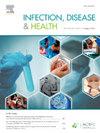Impact of enhanced public health and infection control measures on pediatric hospital-acquired respiratory viral infections during the SARS-CoV-2 pandemic
IF 2
Q2 PUBLIC, ENVIRONMENTAL & OCCUPATIONAL HEALTH
引用次数: 0
Abstract
Background
Visitor restrictions and mask-wearing may reduce hospital-acquired infections (HAI) as part of infection control bundles. The impact of a strict visitor policy and compulsory surgical mask wearing implemented during the SARS-CoV-2 pandemic, but prior to any local community circulating SARS-CoV-2, on the rates of hospital-acquired respiratory viral infections (HA-RVI) was assessed.
Methods
Retrospective audit of a local HAI database for HA-RVI from 1st April 2019 to 29th March 2021 in a tertiary children's hospital. HA-RVI were standardized against occupied bed days (OBD) and admitted community acquired infections (CAI). Rates of HA-RVI were compared during 52 weeks of SARS-CoV-2-associated enhanced control periods (visitor restrictions with and without universal surgical masking), against 52 weeks standard practice. Total respiratory virus infections, respiratory syncytial virus (RSV), and rhinovirus infections were analysed.
Results
Comparing standard practice with enhanced measures, 42 v 15 HA-RVI and 1517 v 691 CAI were noted. Enhanced infection controls resulted in significant reductions in total HA-RVI when adjusted for OBD (p = 0.0038) and CAI (p = 0.0122). Non-significant decreases were seen in hospital-acquired respiratory syncytial virus (HA-RSV) adjusted for both CAI and OBD.
Visitor restrictions combined with universal surgical masks significantly decreased adjusted total HA-RVI compared with visitor restrictions alone (adjusted for OBD p = 0.0123; adjusted for CAI p = 0.0429). HA-RSV decreased non-significantly when mask wearing was combined with visitor restrictions compared with visitor restrictions alone. HA-rhinovirus infections did not decrease with the addition of masks to visitor restrictions.
Conclusion
Enhanced infection control measures introduced with SARS-CoV-2 pandemic decreased some HA-RVI. Universal surgical mask wearing decreased HAI rates more than visitor restrictions alone, except for rhinovirus where the HAI rate remained unchanged.
SARS-CoV-2大流行期间加强公共卫生和感染控制措施对儿科医院获得性呼吸道病毒感染的影响
背景:作为感染控制措施的一部分,限制访客和佩戴口罩可以减少医院获得性感染。评估了在SARS-CoV-2大流行期间,但在任何当地社区传播SARS-CoV-2之前实施的严格访客政策和强制医用口罩对医院获得性呼吸道病毒感染率(HA-RVI)的影响。方法:回顾性审计某三级儿童医院2019年4月1日至2021年3月29日HA-RVI的本地HAI数据库。HA-RVI与占用卧床天数(OBD)和入院社区获得性感染(CAI)进行标准化。在与sars - cov -2相关的52周强化控制期(有和没有普遍手术口罩的访客限制)与52周标准做法期间,比较HA-RVI的发生率。分析呼吸道病毒、呼吸道合胞病毒(RSV)和鼻病毒感染情况。结果:将标准做法与强化措施进行比较,HA-RVI值为42 v 15, CAI值为1517 v 691。当调整OBD (p = 0.0038)和CAI (p = 0.0122)时,加强感染控制导致HA-RVI总量显著降低。医院获得性呼吸道合胞病毒(HA-RSV)在CAI和OBD调整后均无显著下降。与单独的访客限制相比,访客限制联合通用外科口罩显著降低了调整后的总HA-RVI(经OBD调整p = 0.0123;经CAI校正p = 0.0429)。与单独的访客限制相比,戴口罩与访客限制相结合时HA-RSV无显著下降。甲流鼻病毒感染并没有随着游客限制措施的增加而减少。结论:SARS-CoV-2大流行后加强感染控制措施可降低HA-RVI。除鼻病毒外,佩戴通用外科口罩比单独限制游客更能降低HAI率,鼻病毒的HAI率保持不变。
本文章由计算机程序翻译,如有差异,请以英文原文为准。
求助全文
约1分钟内获得全文
求助全文
来源期刊

Infection Disease & Health
PUBLIC, ENVIRONMENTAL & OCCUPATIONAL HEALTH-
CiteScore
5.70
自引率
5.70%
发文量
40
审稿时长
20 days
期刊介绍:
The journal aims to be a platform for the publication and dissemination of knowledge in the area of infection and disease causing infection in humans. The journal is quarterly and publishes research, reviews, concise communications, commentary and other articles concerned with infection and disease affecting the health of an individual, organisation or population. The original and important articles in the journal investigate, report or discuss infection prevention and control; clinical, social, epidemiological or public health aspects of infectious disease; policy and planning for the control of infections; zoonoses; and vaccination related to disease in human health. Infection, Disease & Health provides a platform for the publication and dissemination of original knowledge at the nexus of the areas infection, Disease and health in a One Health context. One Health recognizes that the health of people is connected to the health of animals and the environment. One Health encourages and advances the collaborative efforts of multiple disciplines-working locally, nationally, and globally-to achieve the best health for people, animals, and our environment. This approach is fundamental because 6 out of every 10 infectious diseases in humans are zoonotic, or spread from animals. We would be expected to report or discuss infection prevention and control; clinical, social, epidemiological or public health aspects of infectious disease; policy and planning for the control of infections; zoonosis; and vaccination related to disease in human health. The Journal seeks to bring together knowledge from all specialties involved in infection research and clinical practice, and present the best work in this ever-changing field. The audience of the journal includes researchers, clinicians, health workers and public policy professionals concerned with infection, disease and health.
 求助内容:
求助内容: 应助结果提醒方式:
应助结果提醒方式:


